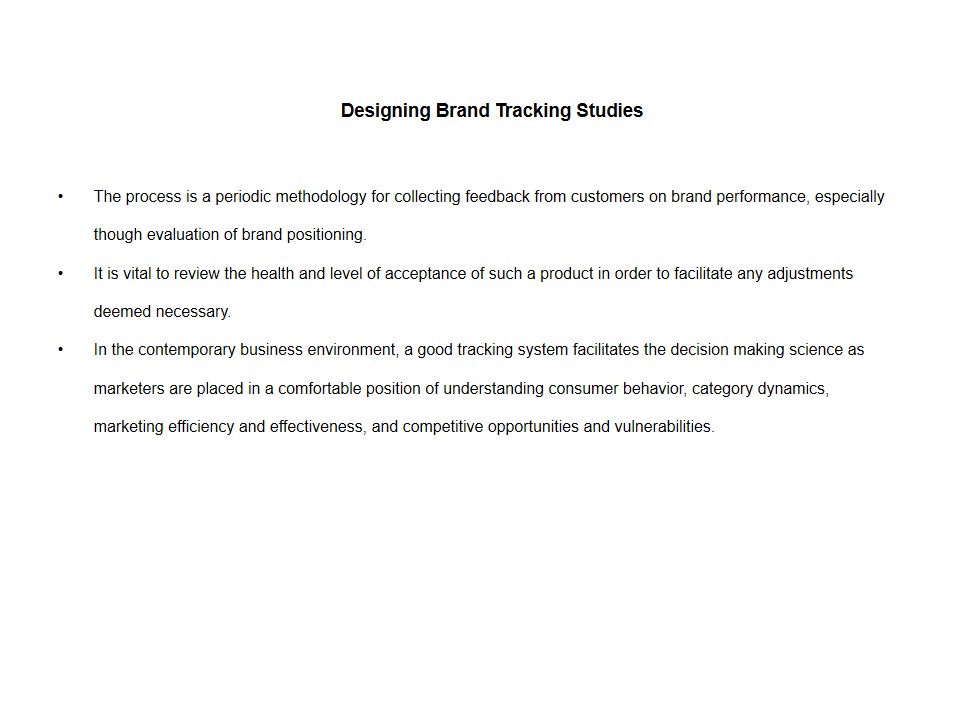Designing Brand Tracking Studies
- The process is a periodic methodology for collecting feedback from customers on brand performance, especially though evaluation of brand positioning.
- It is vital to review the health and level of acceptance of such a product in order to facilitate any adjustments deemed necessary.
- In the contemporary business environment, a good tracking system facilitates the decision making science as marketers are placed in a comfortable position of understanding consumer behavior, category dynamics, marketing efficiency and effectiveness, and competitive opportunities and vulnerabilities.

What to Track
- Product-Brand Tracking:
- Involves quantitative measurement of image and brand awareness.
- Generally, the essence is to track specific aspects of the product and consumer perception on the same. These aspects include imagery benefits and attributes, value and pricing component, brand personality, convenience, and functional performance (Yang, 2005, p. 326).
- Corporate or Family Brand Tracking:
- This tracking criterion deals with concerns, accessibility, ease, and perceived usability as viewed by customers. Basically, the basis of tracking functions on ratings, feelings, and performance at macro level.
- The criterion is very effective in a multi faceted company interested in establishing correspondence, influence and perception customers have on such products.
- Global Tracking:
- This tracking criterion covers a larger and stratified market. Thus, the tools for measurement may not be the same in different localities.
- To establish a reliable verification procedure, the perspective must accompany any study.
- Therefore, the aspects of economic indicators, media indicators, technology, income, and demographic profile are vital in establishing the expansive indicators of tracking.




How to conduct Tracking Studies
Whom to Track
- Establish the object of interest, that is, current customer and potential users.
- Since this population hold different views on the same product, use of questionnaires will draw the clear variance required and establish the relationship existing between different types of customers and general perception.
- Besides, the study might be expanded to capture retailers and sales persons to understand feeling triggered by the product on their beliefs and perception (Yang, 2005, p. 331).


When and where to Track
- According to Millward Brown, tracking modules “depends on modality”(Yang, 2005, p. 331).
- Therefore, frequency of tracking is determined by how often the product is purchased. Through continuous tracking methodology, the interested company can keep trust earned form consumers and will spend less on marketing. Thus, the basis of tracking should revolve around predictability of the market.


How to Interpret Tracking Studies
- For proper interpretation, the collected data should be reliable and consistent.
- Through comparative analysis, especially on a specific attribute, it is possible to establish the relationship between data collected and the market.
- Focus should be based on specific indices and score, not necessarily top level ones.
- Each matrix should be treated independently in order to establish the final relationship that might exist on different variables.


Interpretation of Collected Data
- The focus should minimise response based on emotional and attitudes connections in order to create a non partisan data.
- Therefore, interpratation should be based on “brand health measures”(Yang, 2005, p.332) since they are more multidimensional in addressing actual response for each aspect of the tracking hypothesis.
- This is achievable through quantifying “determinants of brand equity” (Yang, 2005, p. 332) as perceived by respondents.

Reference List
Jonesa, E, Buschb, P & Dacinc, P 2003, Firm market orientation and salesperson customer orientation: interpersonal and intrapersonal influences on customer service and retention in business-to-business buyer–seller relationships. Web.
Mehta, S 2006, Service Delivery Management. Web.
Tweedie, L 2011, Insider – Ethical Salesperson Behaviour in Buyer-Seller Relationships. Web.
Yang, K 2005, Design for Six Sigma for Service: Brand Development and Brand Strategy, McGraw-Hill Professional, Alabama.